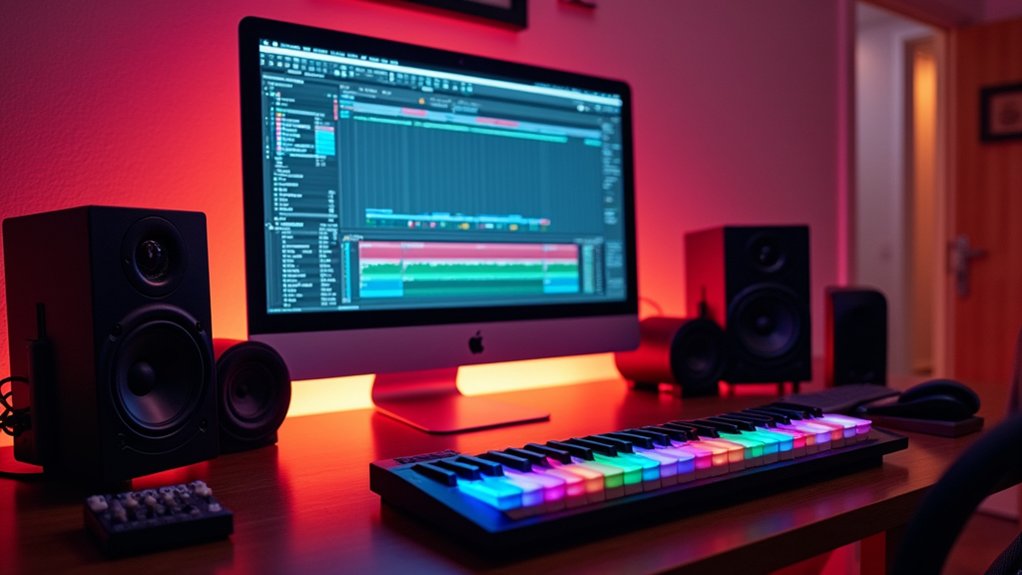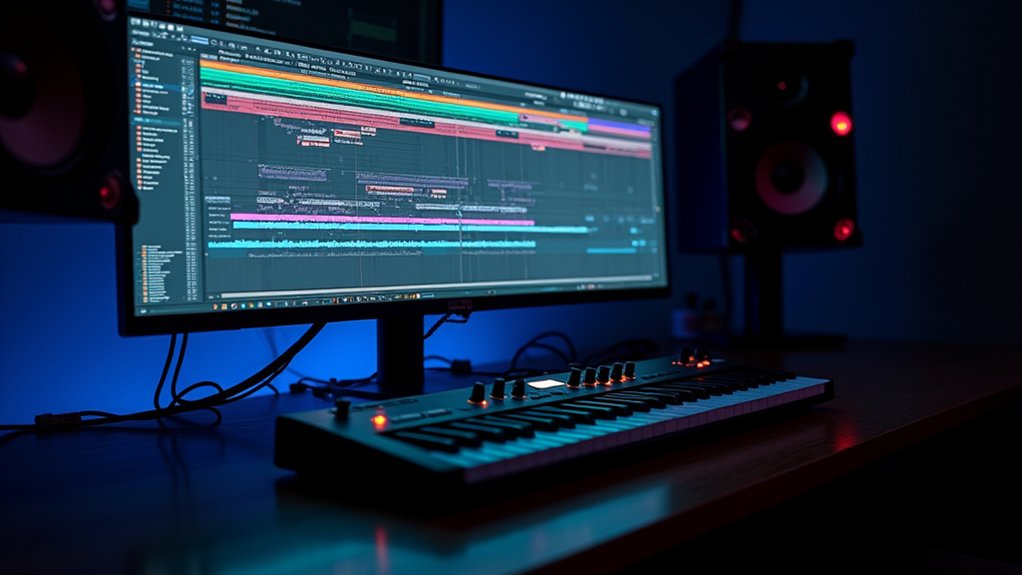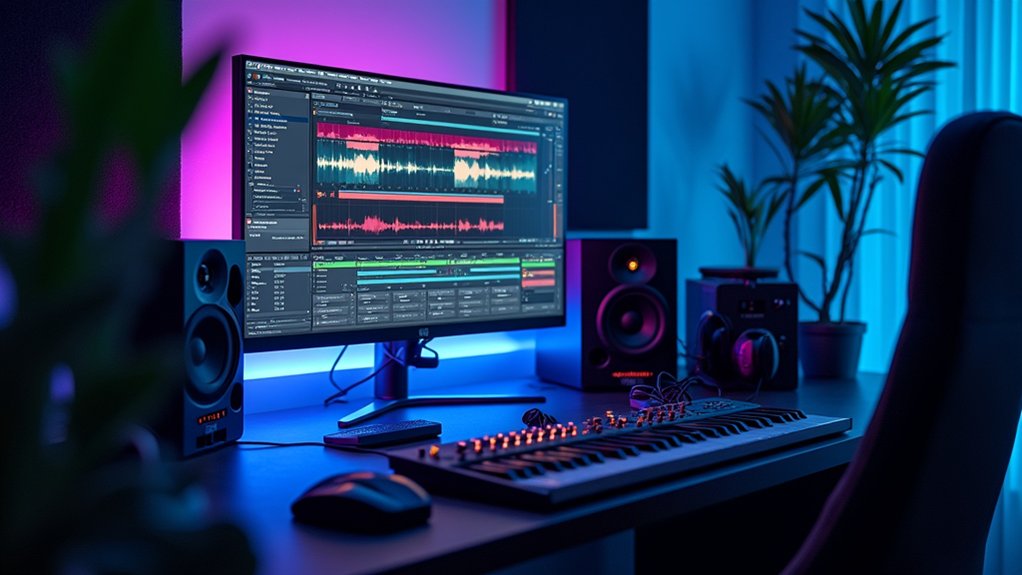NewTone in FL Studio offers a visual, precision-focused interface for advanced pitch correction. Users can import vocals, analyze pitch contours, and apply detailed manual adjustments with drag-and-drop note control, snap-to-grid, and vibrato editing. Timing and note slicing tools allow for surgical corrections without affecting an entire phrase. Formant shifting preserves vocal timbre during tuning. Transparent integration back into the playlist guarantees professional results. Techniques for harmonies, export settings, and workflow strategies are also systematically addressed throughout the guide.
Key Takeaways
- NewTone provides visual pitch editing, allowing precise manual correction of individual notes in vocal recordings.
- Import vocals, set the correct key, and use the piano roll view to identify and adjust out-of-tune notes.
- Utilize advanced vibrato and formant controls to maintain a natural, expressive vocal tone during pitch correction.
- The cutting and time correction tools enable detailed slicing and realignment of vocal segments for tight timing and tuning.
- Export the corrected vocals, align them in your FL Studio playlist, and use transparent mixing techniques for professional results.
Understanding the NewTone Plugin Interface
The NewTone plugin interface in FL Studio presents a visual-centric environment where users can directly manipulate pitch by dragging individual notes within the waveform display. This interface streamlines pitch correction by offering global controls such as centering, variation, and changeover time, which collectively influence the overall pitch correction process across all detected notes.
It is important to remember that manual pitch adjustments can be performed for each note, allowing for surgical tuning while retaining expressive vocal nuances. Advanced editing mode further expands control, providing vibrato manipulation for nuanced tonal shaping.
The NewTone interface also features snap to grid options adjustable by musical divisions, facilitating precision when cutting or shifting note positions. Efficient workflow demands familiarity with these controls to maximize the accuracy and musicality of pitch correction tasks.
Analyzing Vocal Performance for Common Issues
Effective pitch correction begins with a systematic analysis of vocal performance to identify underlying issues such as tuning instabilities and pitch drift.
In FL Studio, importing the vocal track into NewTone allows for a detailed examination of pitch contours. Technicians should scrutinize the piano roll view for subtle deviations—such as a little bit of flat vibrato on words like “room” or “fall”—and more pronounced pitch drift, as seen on syllables like “when.” It is essential to identify these irregularities before applying any reverb, since time-based effects can exaggerate pitch problems. Patterns of consistent inaccuracies may recur across different sessions, emphasizing the need for thorough analysis.
To achieve accurate pitch correction, it is crucial to set the Key correctly, as this establishes the tonal foundation necessary for aligning vocals with the instrumental. Documenting these findings streamlines corrective workflows and guarantees that repeated issues are efficiently addressed in subsequent edits.
Adjusting Pitch With Precision Tools
NewTone enables users to manually drag individual notes to target pitches for detailed correction and creative editing. Precision is further enhanced by activating the snap-to-grid function, allowing note placement to align with specific rhythmic values such as quarter or eighth notes. This workflow guarantees rapid and accurate pitch adjustment while maintaining musical timing integrity. Using tools like Retune Speed in pitch correction software can further enhance the natural resonance of vocals by adjusting how quickly the software corrects the pitch.
Manual Note Adjustment
Utilizing manual note adjustment empowers users to drag individual notes to precise pitches, facilitating targeted pitch correction within a vocal performance.
In NewTone, manual pitch adjustments are accomplished by selecting and dragging notes vertically, allowing for microtonal accuracy and ensuring each segment aligns with the intended melodic line. This workflow is indispensable for addressing subtle tuning discrepancies and achieving vocal performance enhancement without sacrificing authenticity.
For best results, users should leverage note dragging techniques in conjunction with global controls for centering, shift time, and formant shifting.
- Select and drag notes: Click a note blob and move it to the desired pitch for immediate correction.
- Adjust shift and centering: Refine shifts and centralize pitch for smoother, natural-sounding results.
- Apply formant shifting: Preserve vocal timbre integrity during significant pitch changes.
Fine-Tuning With Snap
When precise pitch correction is required, the snap to grid feature streamlines workflow by constraining note adjustments to defined intervals, such as quarter or eighth notes.
Snap settings optimization is essential for users aiming to perform detailed edits without disrupting the vocal’s natural phrasing. By utilizing grid resolution adjustments, one can cut notes into smaller, manageable sections, enabling more granular pitch corrections.
This approach supports precise editing techniques, particularly when subtle tuning is necessary to retain vocal authenticity. Employing the drag selection tool allows seamless transfer of edited segments back to the playlist, maintaining synchronization with the original audio.
For all-encompassing control, global parameters like centering, variation, and changeover time can further refine pitch and timing, ensuring edits remain musically coherent and professionally polished.
Managing Vibrato and Transitions Effectively
Managing vibrato and shifts in NewTone requires targeted manipulation of note segments to control excessive vibrato without sacrificing vocal authenticity.
Workflow optimization includes using advanced vibrato controls and global shift time adjustments to achieve seamless note connections.
Precision editing, such as splitting notes and enabling snap-to-grid, guarantees pitch corrections remain transparent and natural.
Controlling Excessive Vocal Vibrato
Addressing excessive vocal vibrato in FL Studio’s NewTone involves direct manipulation of pitch variation and shift time for each note, allowing for granular control over vibrato intensity.
Through utilizing vibrato control techniques, users can isolate and attenuate problematic vibrato without sacrificing vocal expressiveness.
Key vibrato editing tips include utilizing advanced waveform editing to target specific vibrato artifacts and applying global controls for centering and variation to achieve a natural sound.
Formant shifting can also be integrated to maintain timbral integrity during pitch correction.
Vocal expressiveness strategies recommend iterative listening and adjustment for best results.
- Manually reduce pitch variation on targeted notes using advanced editing.
- Utilize variation and centering sliders for overall vibrato smoothing.
- Apply formant shifting to retain vocal character during vibrato control.
Smoothing Note Transitions
Although vocal editing in FL Studio’s NewTone often centers on pitch correction, achieving seamless note shifts requires careful adjustment of shift time and targeted vibrato control. By manipulating the shift time control, users can optimize timing between notes, preventing abrupt jumps and supporting advanced note blending techniques. Manual pitch correction, combined with vibrato adjustment in advanced mode, guarantees pitch smoothing methods do not strip away expressive nuance. Cutting notes into smaller segments increases flexibility, allowing for micro-edits that fine-tune shifts without compromising the vocal’s character. Regularly reviewing edits in the song’s context is essential; emotional resonance relies on shifts that feel natural.
| Technique | Emotional Impact |
|---|---|
| Fine shift timing | Confidence, flow |
| Gentle vibrato smoothing | Warmth, authenticity |
| Micro note segmentation | Precision, clarity |
| Real-time mix auditioning | Connection, immersion |
Preserving Natural Vocal Tone
After refining note shifts for fluidity, attention shifts to preserving the vocal’s innate tone during pitch correction workflows in NewTone.
Achieving vocal timbre preservation requires deliberate control over vibrato and changes. Operators should leverage advanced editing mode for precise vibrato adjustment techniques—modifying depth and rate without undermining the original performance.
Change times can be fine-tuned globally, guaranteeing seamless note connections and maintaining emotional expression balance.
Formant shifting is integral for preventing artifacts and retaining the vocalist’s unique character. It is practical to frequently audit sections after edits, as fresh listening perspectives can reveal over-correction, allowing for recalibration.
- Employ advanced editing mode to subtly adjust vibrato while retaining emotional nuance.
- Use global change timing for organic note changes.
- Apply formant shifting to guarantee vocal timbre preservation during pitch correction.
Fine-Tuning Timing and Note Placement
Achieving precise timing and note placement in NewTone involves utilizing the time correction tool to slice waveforms, enabling targeted adjustments to vocal phrases or individual notes.
For granular timing adjustments, users should toggle the snap-to-grid setting between quarter and eighth notes, allowing for meticulous note alignment within the timeline.
Employing the drag selection tool facilitates efficient transfer of edited audio back to the playlist, promoting audio consistency across all tracks.
It is recommended to periodically revisit modified sections following short breaks, which aids in identifying subtle timing discrepancies and maintaining the natural flow of the performance.
Aligning edited vocal timing with the original reference is essential for preserving performance integrity while improving overall sound quality.
This workflow guarantees professional-grade timing correction without sacrificing musical expressiveness.
Utilizing Formant Shifting for Natural Vocals
When applying pitch correction in NewTone, precise use of formant shifting is essential for preserving the original vocal character and timbre.
Users should monitor for unwanted artifacts by making incremental adjustments, especially when processing vowels, to maintain clarity and prevent synthetic tonal shifts.
Integrating formant control with pitch editing guarantees the resulting vocals retain natural expressiveness and avoid the processed sound often associated with aggressive correction.
Preserving Vocal Character
While processing vocals in FL Studio’s NewTone, preserving the original character of a performance is achieved by using formant shifting to adjust tonal qualities independently of pitch. This workflow is key for vocal texture enhancement and maintaining emotional resonance preservation throughout pitch correction.
Subtle formant adjustments prevent the timbral distortions commonly associated with aggressive pitch manipulation. Producers should focus on the following steps:
- Isolate and Analyze – Solo the vocal, engage the formant control, and monitor in real-time for tonal integrity.
- Apply Subtle Formant Adjustments – Make incremental changes, guaranteeing the vocal retains its natural warmth and avoids nasality or artificial brightness.
- A/B Comparison – Regularly toggle between processed and unprocessed audio to confirm emotional and tonal authenticity are maintained.
This approach guarantees a natural, expressive vocal result.
Preventing Unnatural Artifacts
Frequently, producers encounter unnatural artifacts such as robotic tones or synthetic overtones during aggressive pitch correction in FL Studio’s NewTone. To address these pitch correction challenges, integrating formant adjustment techniques is essential.
Formant shifting in NewTone enables users to manipulate the pitch while conserving the vocal’s authentic timbre, minimizing the risk of artifacts. Workflow best practices involve simultaneously adjusting formant and pitch controls with each modification. This dual approach helps maintain emotional resonance and vocal authenticity, even with substantial pitch shifts.
Employing artifact detection methods, such as soloing the affected vocal or using spectral analysis, allows for immediate identification of synthetic overtones. Continuous monitoring of formant parameters throughout the editing process guarantees the final vocal remains natural and free from detrimental processing artifacts.
Cutting and Editing Notes for Detailed Corrections
Achieve detailed vocal corrections in NewTone by utilizing the cutting tool to slice audio notes into smaller, manageable segments, enabling precise adjustments to pitch and timing.
Employ advanced slicing techniques by adjusting the snap-to-grid resolution to eighth notes or finer, which provides granular control for intricate edits. This workflow not only enhances vocal alignment strategies but also improves the editing process for maximum efficiency.
Once segmented, individual notes can be manipulated for pitch, volume, and gain, allowing tailored corrections without affecting the entire phrase. The advanced editing mode further refines results by controlling vibrato and micro-pitch variations, preserving natural vocal expression.
- Set snap-to-grid to finer increments for precise advanced slicing techniques.
- Drag and adjust individual note segments for ideal vocal alignment strategies.
- Utilize advanced editing mode for editing workflow enhancement and natural-sounding corrections.
Creating Vocal Layers and Harmonies
Following detailed pitch and timing adjustments, creating vocal layers and harmonies in NewTone involves a methodical approach to multi-track management.
Employ vocal layering techniques by recording multiple single-note takes, then individually processing each for pitch and timing consistency.
When harmonizing vocal tracks, utilize the drag selection tool in NewTone to transfer edited layers into the FL Studio playlist, ensuring precise alignment with existing elements for cohesive blends.
Address timing and pitch discrepancies rigorously to prevent dissonance that can detract from harmonic clarity.
For enhancing vocal dynamics, apply subtle EQ and level adjustments post-pitch correction, preserving the authenticity of the original performance.
Periodically reassess the processed vocals, maintaining a balance between pitch-perfect harmonies and natural vocal expression to avoid an overly artificial result.
Exporting and Integrating Corrected Vocals
Once vocal corrections are complete in NewTone, the next step is to efficiently export and integrate the processed audio into the main FL Studio project.
Precision in exporting settings and vocal alignment is critical for a seamless workflow. Use the drag selection tool to transfer the corrected audio to the FL Studio playlist, ensuring that timing and phrasing match the instrumental.
Before finalizing, scrutinize the processed take for artifacts, as these can compromise the mix.
- Export the corrected vocal using ideal exporting settings to retain fidelity and prevent unwanted processing.
- Align the vocal in the playlist with existing tracks, adjusting timing for perfect vocal alignment with the project’s tempo and groove.
- Apply mixing techniques such as EQ and reverb, ensuring the corrected vocals blend transparently within the mix.
Balancing Pitch Correction With Authenticity
How can one maintain the integrity of a vocal performance while applying pitch correction in NewTone? The key lies in recognizing and avoiding common pitch correction pitfalls, such as excessive quantization that results in unnatural, robotic tonalities.
Practitioners should prioritize manual adjustment of individual notes to retain subtle pitch variations that convey emotional expression. Comparing the original and processed versions during editing guarantees that authenticity is not sacrificed for technical accuracy.
Advanced features like formant shifting and vibrato control enable nuanced tuning, preserving the natural vocal timbre preferred by most listener preferences.
Treat pitch correction as a tool for enhancement rather than transformation; subtlety is essential. This workflow-oriented approach guarantees that the corrected performance maintains both technical precision and genuine character, satisfying both musicality and audience expectations.
Best Practices for Professional-Sounding Results
While precise pitch correction is essential for modern vocal production, achieving professional-sounding results in NewTone requires a meticulous, workflow-driven approach.
Professionals integrate advanced editing techniques and vocal tuning strategies to refine performances while retaining natural expressiveness. Employing manual pitch correction allows for targeted adjustments, ensuring subtlety and emotional integrity. Formant shifting further preserves vocal character, preventing artifacts that can detract from authenticity.
Performance enhancement tips include the consistent use of vibrato control and A/B comparisons to validate edits. For ideal workflow, consider the following:
- Apply manual pitch edits selectively to maintain natural phrasing.
- Use formant shifting and vibrato control in advanced mode for nuanced tuning.
- Continuously A/B test edited and original tracks, checking for artifacts and reverb-induced pitch smearing in the mix.
In addition to native autotune plugins like NewTone, FL Studio supports third-party autotune plugins, offering a broader range of features for diverse vocal production needs.
Frequently Asked Questions
How to Do Pitch Correction in FL Studio?
Pitch correction in FL Studio involves pitch shifting and vocal tuning using specialized plugins. Users perform audio manipulation by dragging note segments, adjusting pitch centers, applying global controls, fine-tuning formants, and comparing edits to maintain natural vocal quality and timing.
What Is Newtone Pitch Correction?
NewTone pitch correction is a workflow-oriented plugin offering features like detailed pitch, time, and formant editing. Practical NewTone tips include precise note manipulation. Users seeking alternatives may consider Melodyne, Auto-Tune, or Waves Tune for similar functionality.
Is Newtone Included in FL Studio?
NewTone is included in FL Studio’s Signature Edition, streamlining pitch correction workflows. Users access NewTone features after installation, though alternative plugins exist. Efficient integration allows for precise vocal editing, enhancing production without requiring external NewTone alternatives.
Is Newtone the Same as Melodyne?
NewTone vs. Melodyne highlights distinct workflows; while both offer pitch and timing correction, NewTone features seamless FL Studio integration. NewTone capabilities include note dragging and vibrato editing, but Melodyne provides more advanced tools for complex audio manipulation tasks.
Conclusion
Mastering pitch correction with NewTone in FL Studio requires a systematic approach: understanding the interface, identifying pitch and timing discrepancies, and applying precise edits using advanced tools. Effective vibrato management and seamless shifts are essential for natural results. Integrating harmonies and exporting cleanly guarantees workflow efficiency. Ultimately, balancing technical correction with vocal authenticity is key. By adhering to best practices, producers can achieve professional, transparent pitch correction that enhances vocal tracks without sacrificing musical expression.




